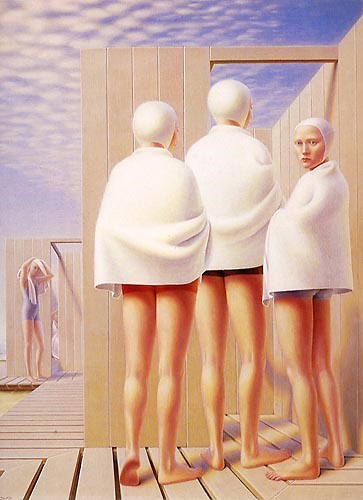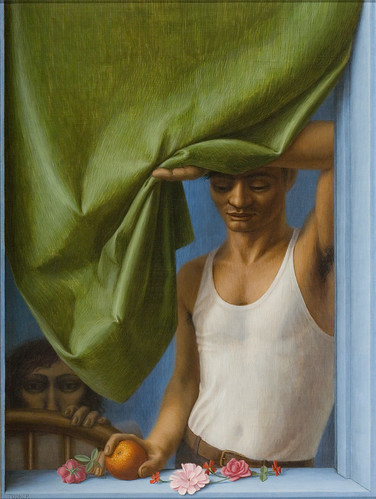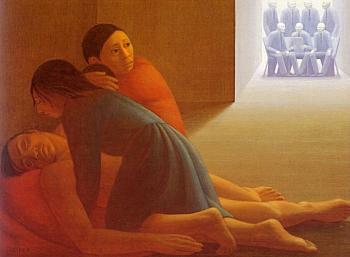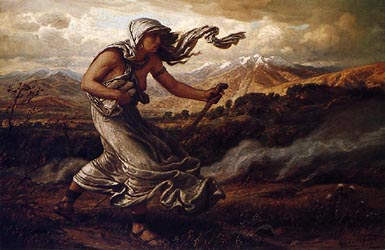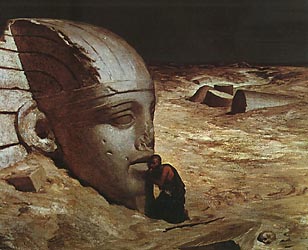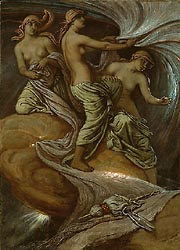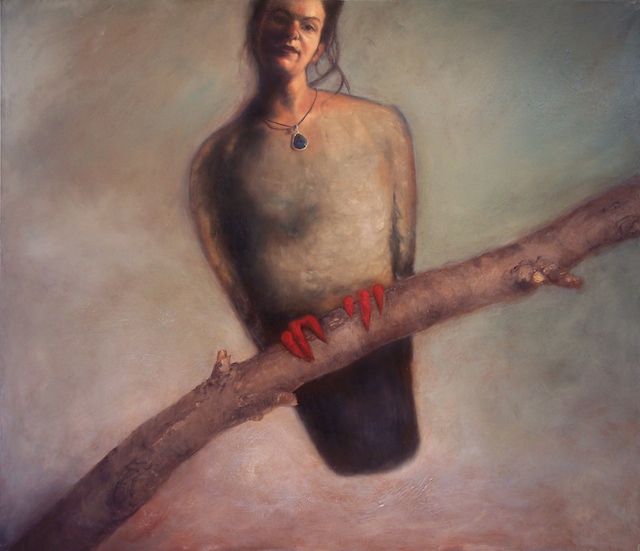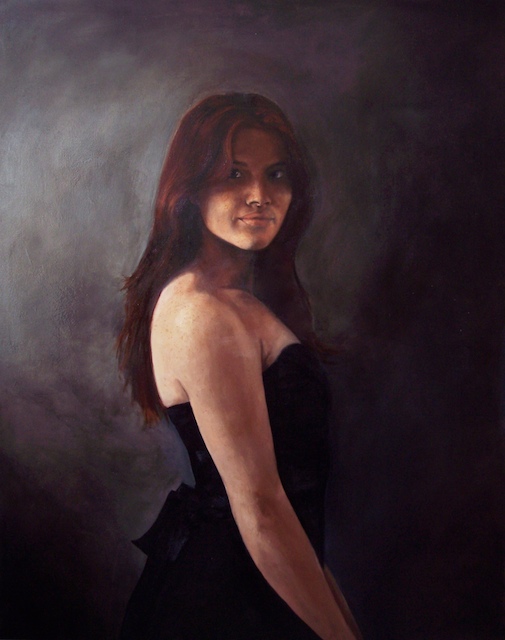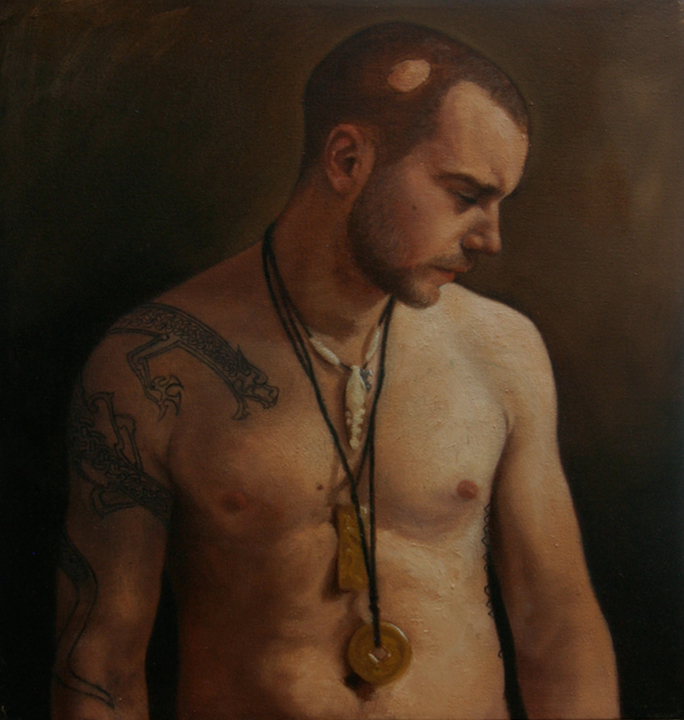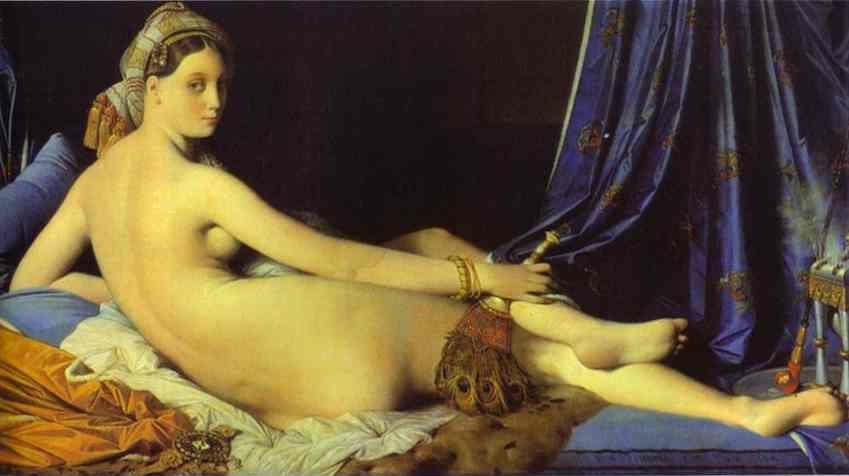INTERVIEW WITH JASON JOHN
Jason John is an exciting and ambitious young painter. You may have recently seen his work on the magazine rack at your local bookstore. He was featured on the cover of BlueCanvas, a quarterly art magazine, in which featured artists are essentially voted in by members of
bluecanvas.com. He is a founding member of
the Broadstreet Studio, and recently helped put together "
Between realities", an exhibition of outside-the-box realist painting at
Principle Gallery in Alexandria, Virginia, in which Jason and myself were participating artists. Between Realities made the cover of the January 2010 issue of
American Art Collector. See more of Jason's work
here.
Most of your work involves an unusual narrative element of some sort. Is there a specific symbology behind the costumes and figure arrangements or is composition more of an intuitive process for you?
I feel that beyond any specific symbols, my paintings ‘attempt’ to represent behaviors in a ritualistic costume that I invent. I have always felt that the ‘characters’ in my pieces are in a constant violent physical and emotional control game with each other. Sometimes this altercation is primal and sometimes more strategically psychological and architectural. I feel that I try to convey representation through painting as maybe a moment of rest between these psychological role-playing battles that take place beyond the time of the picture window. I see the representations almost like that of a deer caught in headlights. The headlights shine on the deer and the action of survival materializes for a moment… a second later the moment is gone. I really feel that I have been trying to work out this kind of representation.
Can you explain your repeated use of paper in your paintings?
I feel that the paper came as a kind of mistake as every artist knows the crap lying on the floor of your studio can be magic. I was more interested in the mask or veil to conceal identity and really liked the physicality and abstractness of the paper. I can’t quite remember when I started using paper masks, but it was nice that cardboard and paper could be manipulated in so many ways including writing/ taping/ tearing etc. When the paper is crumbled and torn it takes on a whole new world. The thing that is most interesting about masks and armor made of paper and cardboard is this material’s commodity function of consumption and discard. The masks are so disposable that they have a bit of irony attached, almost like you really cannot take their purpose serious.
 |
| Souled Out, Oil and Wax on Linen 24"x34" |
Is there much drawing underneath in your process or is it mostly direct?
You know that is an interesting question because I used to start these paintings with a quick pencil drawing, but lately have been using Indian Ink Markers. I have been using the markers to just go crazy and write and draw etc. Most of it is covered up, but as I have been working on my most recent work, I have been trying to reveal these hot spots in places through transparent patches.
How important is direct life study from the model?
Uh well I love drawing from life. I teach figure and draw from the model as much as I can. As for my work it means not too much more than a point of reference.
Where are you from?
Originally I was from Detroit, but grew up in the Poconos and Wilkes Barre, PA. I lived in Pittsburgh for a while and now am living in Jacksonville FL teaching at University of North Florida.
How large do you work?
I used to work small and in grad school went to really big pieces/ wall size- I guess like all ambitious grad students. When I got out of grad school I realized the cost it was to ship work and went really small. Lately I have been moving back up in scale. A lot of my pieces are about four feet, but I cannot get much bigger than this due to limited studio space. I still do small work when I want to experiment with something.
 |
| Kiss of Judas, Oil and Wax on Linen 18"x21" |
Where and how did you train?
I studied at the Waichulis Studio off and on for approximately three or four years. I met Josh and Adam Vinson at the Waichulis Studio. I was going to Kutztown at the same time as my studies at the Waichulis Studio. For graduate school I went to IUP and this is where I met Brian. After graduate school I shared a studio with Josh for about three years. Brian joined us about a year later.
What is Broadstreet Studio?
This one I am not so sure how to answer. I guess we are a three-person artist group. We do a lot of things through the group and run it pretty chaotically, but hell that is what keeps it fun. I guess the one rule is that you have to like good beer to be in Broadstreet. We are all three homebrewers. There is no real leader in the group. We all seem to make democratic decisions together with minimal bickering. I guess we all just kind of get along pretty good to say the least.
 |
| Big Fix, Oil on Linen 10"x10" |
How long have you been friends with the core Broadstreet group?
Originally Josh and I created Broadstreetstudio more or less as a school, but slowly the enterprise transformed into a small artist group. I had met Brian in Graduate School two years before Broadstreetstudio. We asked Brian to join because we were all friends and Josh and I really respected his work, while Brian’s work remained different.
Were you pleased with how the "Between Realities" show went at Principle Gallery? Do you plan on putting together more shows like this in the future?
I think this show proved a lot of things: That artists can work together to achieve a common goal. The show itself was a real fun time and although we wanted to show artists we respect, we have met a lot of new artists since then. We have been trying to organize another show, but due to the economy it has been hard to pin down a space. A lot of us have been talking about doing another show. I think a lot of people were commenting on how each piece held it’s own.

